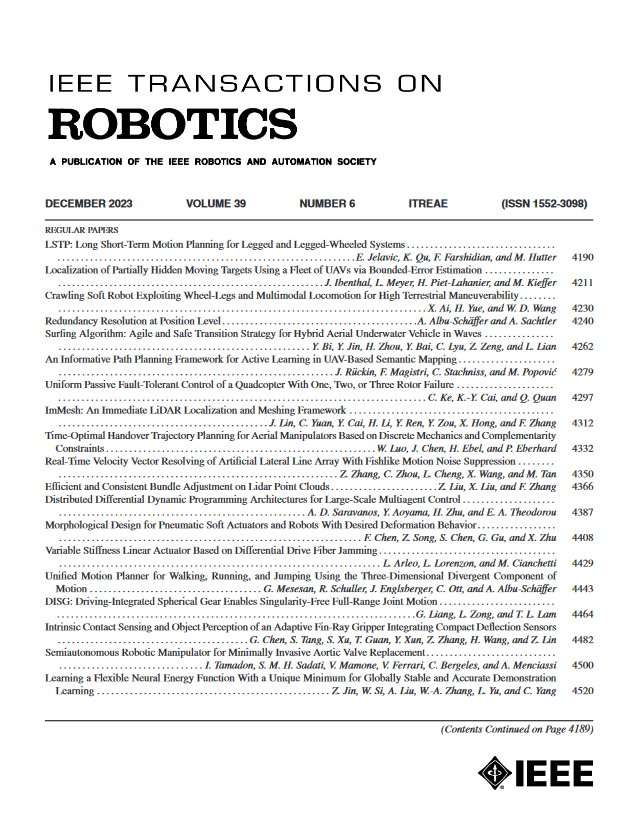具有成本效益和可修复的气压触觉传感器的位置和方向超分辨率传感
IF 10.5
1区 计算机科学
Q1 ROBOTICS
引用次数: 0
摘要
触觉传感器的高成本和易碎性阻碍了其在机器人技术中的应用。我们设计并验证了一种具有成本效益且坚固耐用的气压触觉传感器阵列,其材料成本低于80美元。与过去的工作不同,我们没有在气压计上塑造橡胶表面,而是将其作为一个单独的元素,从而使设计易于制造和维修。应用机器学习技术提高传感器的定位精度,将有效分辨率从6mm(相邻气压计之间的距离)提高到0.284 mm。为了研究定位模型的鲁棒性,我们利用E-TRoll机器人抓取器将不同形状的棱柱形物体滚动过安装在一根手指上的传感表面。在这些不受控制的设置下,我们获得了令人满意的平均实时定位分辨率,在2.66 mm以内。此外,我们展示了一种新的实际应用:E-TRoll模拟了一个单自由度平行夹具,推断立方体相对于传感器的方向。将方向范围划分为4类,训练后的CNN-LSTM模型预测方向的准确率为86.91%,交叉验证准确率为5倍。本文章由计算机程序翻译,如有差异,请以英文原文为准。
Location and Orientation Super-Resolution Sensing With a Cost-Efficient and Repairable Barometric Tactile Sensor
The adoption of tactile sensors in robotics is hindered by their high cost and fragility. We designed and validated a cost-effective and robust barometric tactile sensor array, whose material cost is below 80 USD. Unlike past work, we do not mold the rubber surface over the barometers but instead keep it as a separate element, leading to a design that is easy to fabricate and repair. Machine learning techniques are applied to enhance the sensor's localization precision, increasing the effective resolution from 6 mm (the distance between adjacent barometers) to 0.284 mm. To investigate the localization model's robustness, we utilized an
E-TRoll
robotic gripper to roll differently shaped prismatic objects across the sensing surface mounted on one finger. Under these uncontrolled settings, we achieved a satisfactory average real-time localization resolution of within 2.66 mm. Furthermore, we demonstrate a novel practical application: The E-TRoll mimics a one-DoF parallel gripper inferring a cube's orientation relative to the sensor. The range of orientations is split into four classes, which a trained CNN-LSTM model can predict with an 86.91% five-fold cross-validated accuracy.
求助全文
通过发布文献求助,成功后即可免费获取论文全文。
去求助
来源期刊

IEEE Transactions on Robotics
工程技术-机器人学
CiteScore
14.90
自引率
5.10%
发文量
259
审稿时长
6.0 months
期刊介绍:
The IEEE Transactions on Robotics (T-RO) is dedicated to publishing fundamental papers covering all facets of robotics, drawing on interdisciplinary approaches from computer science, control systems, electrical engineering, mathematics, mechanical engineering, and beyond. From industrial applications to service and personal assistants, surgical operations to space, underwater, and remote exploration, robots and intelligent machines play pivotal roles across various domains, including entertainment, safety, search and rescue, military applications, agriculture, and intelligent vehicles.
Special emphasis is placed on intelligent machines and systems designed for unstructured environments, where a significant portion of the environment remains unknown and beyond direct sensing or control.
 求助内容:
求助内容: 应助结果提醒方式:
应助结果提醒方式:


